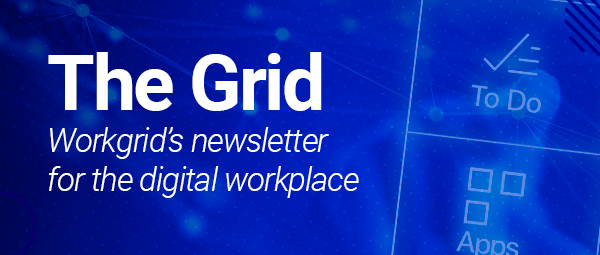The Workgrid team had the pleasure of participating in the 2023 Gartner Digital Workplace summit, which was full of insights, learnings, and guidance across all aspects of the digital workplace.
Overall, the conference was full of energy with digital workplace leaders rallying together to find solutions and new ideas to make the digital workplace better for employees. Here are a few common themes we heard conversing at the booth and throughout analyst sessions.
1) Focus Your Digital Employee Experience on Helping Employees
Employees are having difficulties with technology at work and as a result the digital employee experience is suffering. This was a common theme across many sessions. Over the last few years, the problem has only gotten worse, as many organizations have had a technology-led approach instead of an experience-driven approach.
Since the pandemic, technology has been implemented at an unprecedented rate. Gartner shared survey results that showed on average 11 applications are used on a daily basis, up from 6 in 2019 with:
36% of employees reporting using 11-13 applications
5% report using 26+ applications
Now you may be thinking, eleven isn’t that many…but when you compare that to the average in 2019, the number of applications per user has almost doubled!
The complexity of all these applications in your digital workplace is causing digital friction with serious consequences.
![[asset] impact-of-application-sprawl](https://images.ctfassets.net/z7p73u8c0thn/3mTcfTPBXBxbJOjdkO64jO/9bc879df7ba7b5276c60e372bd36fc0d/impact_of_app_sprawl__1920____1080_px_.png?w=1200&h=675&q=60&fm=png&bg=transparent)
One of the major culprits of digital friction is that when we purchase new tools, we do not decommission the old systems the new tools were brought in to replace. Words of advice that Gartner shared:
Understand the factors that contribute to adoption readiness. There are both external and internal factors from corporate culture, leadership behavior, financial structure, ownership and organization change.
Make the digital employee experience a priority with an experience-led approach, not a technology led approach.
Create a program around your digital employee experience and define the values you want your digital employee experience to support.
Help employees learn what is the right tool for their job and help teams form strategies for how they work (when to use email vs. other tools, etc.)
Promote digital dexterity and champion digital skills
2) Employee Experience Metrics Will Be Leveraged in New Ways
We can expect that everything in the future of work will be measured. But the question is, how will we put this information to use? Although there is a lot of disparity in how people feel about being monitored at work, in our personal lives the average person is comfortable with brands like Amazon or Netflix using our behavior metrics to recommend things like new book titles or movies. This is because there is a benefit exchanged for us as consumers.
Surprisingly, the same sentiment exist in the workplace. According to a Gartner survey, the majority of employees agreed they are comfortable with having their activity monitored as long as the data is used to benefit the employee.
So, what type of monitoring do employees accept in return for being more productive? Surveyed respondents said they would be interested in the following insights:
I want to be aware of career development.
I want help finding information to do my job.
Solve my problems proactively so I don’t have to call you (IT support).
I want you to streamline my notifications.
Get advice on performance improvement.
The key with any type of monitoring is to be transparent with what you are measuring, what you are using the data for, who has access to the data, and allowing employees to opt-in instead of opt-out. Build with privacy by design, allowing people to opt-in exchange for what’s most important to them. Most importantly, keep trust with employees, and refrain from using the data in ways that do not benefit the employee such as monitoring all their device activity.
Gartner sees a new technology category emerging called Workstyle Analytics which is a data-driven method to identify digital friction impacting worker performance and organizational productivity while protecting employee privacy.
The capabilities of Workstyle Analytics include looking at data across workers app usage, data across systems from calendars to time clocks, organization structure, and collaboration patterns to analyze working behaviors to provide workers positive outcomes including skill development, guided attention to help with notifications across applications, and nudges that help inform employees with information that benefits them (DEI, wellness, efficiency tips, etc.).
![[asset] workstyle-analytics-capabilities](https://images.ctfassets.net/z7p73u8c0thn/2VOpRxHgPz6Uxgceve15j8/4109481e81d18669b2943053ec375a9d/workstyle-analytics-cap.png?w=1200&h=670&q=60&fm=png&bg=transparent)
3) Hybrid Work Must Be Flexible, Not One Size Fits All
There were various conversations and sessions discussing hybrid work. The key takeaway is that there is no one size fits all approach or answer.
![[asset] gartner-preference-hybrid-work-arrangement](https://images.ctfassets.net/z7p73u8c0thn/1xo34Lo5rXeumpbXT7dBWp/9fbbe81c10cfe5b5715c7d2ebe46a950/new-preferences-of-hybrid-work-schedules.png?w=1200&h=673&q=60&fm=png&bg=transparent)
Much of the guidance given focused on understanding the wants and needs of employees and designing programs around how they prefer to work – which includes considering also changing how work is coordinated.
Coming into the office for many will require a motivator, obligation, or inspiration. Face time with colleagues was discussed as a main driver for employees. If your organization is having employees come into an office and they are essentially working by themselves, advice was given to consider changing or being flexible on how work is coordinated.
For example, in-office work can be coordinated by local areas and or by project. Consider having projects worked on by people who can go to the office on the same day, ensuring the face-to-face interaction if that is a benefit for your organization. An entire session was dedicated to the concept of using a gig-style approach to coordinate work for effective hybrid working. Using gig-platform principles, the platform or technology would match up workers based on their skills and experience and where/how they work to projects and jobs. To effectively scale work coordination and internal talent mobility, automation is key to match work to workers. Similarly, leaders should ensure there are different working spaces that accommodate different behaviors.
Consider what brings employees into the office? Create spaces for concentration, confidentiality, collaboration, and what Gartner described as collision-meeting, workspaces that allow people to meet new people. Meeting new people at work is an important aspect of building relationships and connections that has likely been down since remote work has taking over.
As we look forward, it’s clear that the digital employee experience will continue to evolve as technology and work styles do too. Navigating these waters can be tricky, but leaders should invest in experience-driven tactics that focus on their employees’ needs.
Big change will require a new mindset and approach, one that views employees like consumers and focuses on delivering digital workplace experiences instead of technology solutions.
If you’re looking to take action right now and start improving your digital employee experience, Workgrid’s AI Assistant takes an intelligent approach to experience-driven design by empowering employees with a frictionless experience for accessing everything they need to know and take action on across all their systems. By surfacing communications, alerts, and tasks in the existing channels employees work in, Workgrid dramatically reduces digital friction and helps employees spend more time on the meaningful work they were hired to do.
If you’re interested in learning more, contact us today for a product demonstration!




